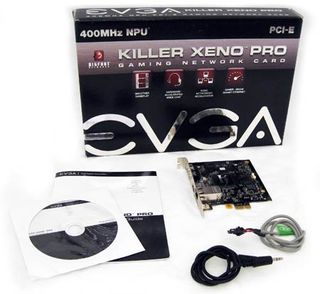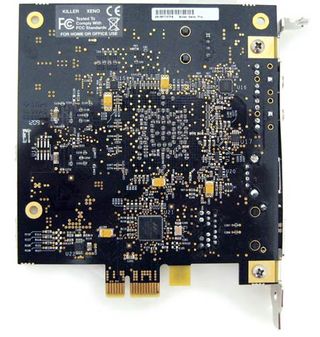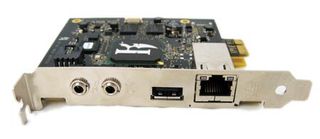Killer Xeno Pro: Do You Really Need A Gaming Network Card?
The Killer Xeno Pro Gaming Network Card
Bigfoot Networks' has taken a page from the Nvidia/ATI handbook and will license the Killer Xeno Pro to other manufacturers to produce the card and apply its branding. Our test sample is an EVGA-brand Killer Xeno Pro. At first glance at the box, you might even mistake it for a graphics card.

Included in the bundle is a driver CD, instruction manual, internal and external audio cables, and of course, the Killer Xeno Pro network card.

The card itself is surprisingly small and unassuming. It includes an audio input, an audio output, a USB port, and of course, the 8P8C network port. In an age where high-performance graphics cards can eat up a good portion of the room inside your chassis, the Killer Xeno Pro's gaming orientation had us expecting something a little larger. There's a nice reflective Killer logo on the processor, but if more bling is your thing, then the Killer Xeno Ultra might be more up your alley, as it adds a LED display and knife-like decoration to the card, as well as 256 MB of RAM. But since our test sample is the Killer Xeno Pro and not the Ultra, let's concentrate on the basics.

Notice that the Killer Xeno Pro is a PCI Express (PCIe) x1 card, so it'll work in any open PCIe slot, all the way up to x16 connectors. This is probably the biggest difference between the Killer Xeno Pro and its predecessors, Bigfoot's Killer NIC and Killer K1. The PCIe bus does allow for greater bandwidth than the old PCI bus, but this probably wouldn't come into play while gaming, since your Internet connection would serve as the bottleneck long before the PCI bus. Still, it's a nice upgrade if you have a Gigabit LAN at home and don't want a shared PCI bus limiting your large file transfers.

The card also has a USB port. When asked about it, Bigfoot Networks let us know that the USB port is used in the manufacturing process, but in the future, the firm plans to enable it for fully offloaded storage that will bypass your system and bring FTP or torrent files directly to a USB device. Sounds like it might be a nifty feature, but we're not sure what kind of real-world advantages you could expect from doing this.
On the hardware specification side of things, the card boasts an integrated 400 MHz PowerPC-based NPU (network processing unit) and 128 MB of onboard DDR2 RAM. The card is essentially a compact Linux PC on a card. There's also an integrated audio chip to offload CPU cycles that may be eaten by gaming chat software.
What does all of this hardware promise to deliver? Smoother game play, network acceleration, bandwidth control, a firewall, and lag-less BitTorrent transfers to name a few capabilities. But these features are more closely aligned with the software side of the Killer Xeno Pro, so let's delve into that a little.
Stay on the Cutting Edge
Join the experts who read Tom's Hardware for the inside track on enthusiast PC tech news — and have for over 25 years. We'll send breaking news and in-depth reviews of CPUs, GPUs, AI, maker hardware and more straight to your inbox.
Software
Bigfoot Networks claims that one of the main advantages of the Killer Xeno Pro is its ability to bypass the Windows network stack, transferring packets directly to and from the game. According to Bigfoot, the Windows network stack is optimized for bandwidth and not latency, so bypassing it should make your networked game more responsive. It says huge advantages can be seen when using the Killer Xeno Pro, such as a 24% increase in frame rates when playing Team Fortress 2 and a 10% increase in frame rates when playing World of Warcraft. It also says there is a 38% performance improvement in latency when downloading files and streaming Internet video while playing World of Warcraft. This sounds fantastic for a network card, so we'll definitely test these claims.
The included software has packet-optimization settings as well as bandwidth-limiting settings for all network-using applications it detects. It automatically attempts to detect if an application is a game and, if so, gives the game network prioritization. Using these features allows the Killer Xeno Pro to give games a priority over other applications, and this is likely the Killer Xeno Pro's real strength, allowing you to simultaneously download files and play without making your gaming suffer.
Finally, an upcoming feature is the Killer Hardware firewall, but it's not quite ready yet. Bigfoot Networks plans to have a download available this summer, it says.
-
tryceo I won one of these from wowhead.com, but i havent fitted it inside the case yet...Reply
IMO its a waste of money... I just keep my internet idle when im playing online.. plus you can get a better upgrade for your GPUs if you dont spend money on this... -
eddieroolz Wasn't there an article similar to this a while back, and everyone bashed it saying that it was pointless? (It was, but just saying)Reply
Doesn't seem like its still worth the premium yet. -
haplo602 try a quality server NIC like an intel f.e. and you'll see better results for less money, the killer nic and derivates are just hyped nonsenseReply -
IronRyan21 eddieroolzWasn't there an article similar to this a while back, and everyone bashed it saying that it was pointless? (It was, but just saying)Doesn't seem like its still worth the premium yet.eddieroolzWasn't there an article similar to this a while back, and everyone bashed it saying that it was pointless? (It was, but just saying)Doesn't seem like its still worth the premium yet.Reply
When I saw the headline for the articles, I was thinking the same thing....Yes, they did an article before and yes this product is pointless. +1 eddieroolz -
tryceo yep... after about 1 minute of testing(removed 1 9800 GTX) The lagg is still there.Reply
If anyone wants mine tho... willing to sell it for $90. it just got opened.. -
Neggers Some important testing is not done here which I would like to see.Reply
I live in Australia and I am a WoW player on the US servers, so a typical ping for me is 250-300 and 300-400 when raiding.
Now when you guys are testing with a 60 ping a difference of 10% for you is going to be 6ms and not going to translate into anything noticeable.
However for someone like me, if this card can improve my connection with the WoW servers by 10%, that could be upto 40 or 50 ms, which could be a huge difference.
So I would like to see more testing done in Higher ping situations, prehaps if you guys tested connection to MMO server in korea or europe, so you were testing in a 300+ ping enviroment, and see if this effects the results. -
cangelini NeggersSome important testing is not done here which I would like to see.I live in Australia and I am a WoW player on the US servers, so a typical ping for me is 250-300 and 300-400 when raiding.Now when you guys are testing with a 60 ping a difference of 10% for you is going to be 6ms and not going to translate into anything noticeable.However for someone like me, if this card can improve my connection with the WoW servers by 10%, that could be upto 40 or 50 ms, which could be a huge difference.So I would like to see more testing done in Higher ping situations, prehaps if you guys tested connection to MMO server in korea or europe, so you were testing in a 300+ ping enviroment, and see if this effects the results.Reply
I never understood why the AUS guys would play on mid-west servers. I knew some really nice raiders from Australia, but they'd lag everyone and either do lower DPS or be unable to tank as a result. Not their fault, but they had way more success playing on Oceanic servers when they eventually swapped over.
Most Popular

